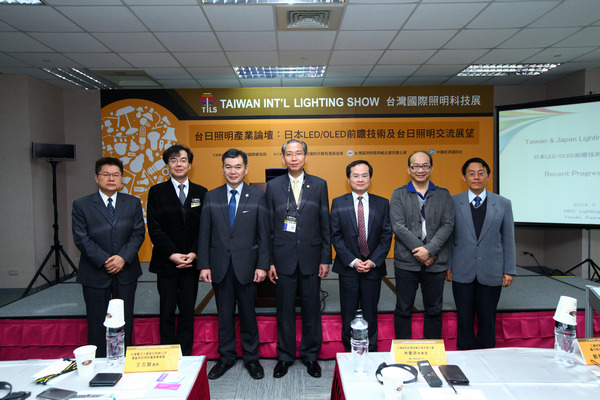Advocates for OLED have argued the technology offers better lighting quality in terms of color temperature, health, and saves materials, according to panelists at Taiwan and Japan Lighting Industry Forum at Taiwan International Lighting Show (TILS) 2014 at Taiwan World Trade Center Nangang Exhibition Hall, Taipei, Taiwan that ran from March 20 to 24, 2014.
 |
|
Taiwan and Japan Lighting Industry Forum panelist experts from left to right: Calvin Wang, Director of Lighting Power Business Unit, Delta Electronics, Yasuki Kawashima, SSL Application Engineering and Development Department Manager, NEC Lighting, Kenji Sugiyama, Vice Chairman, Committee of Intenraitonal Affair, Japan Lighting Manufacturers Association (JLMA) Chairman of TLFEA Steven Lin, C.T. Liu, Vice President & EOL, ITRI, Jwo-huei Jou, Professor, Department of Materials Science and Engineering, National Tsing-Hua University, Money Chen, Special Assistant, President Office, Epistar. (Photo Courtesy of TAITRA)
|
“Lighting should no longer be about brightness, but about offering good quality light,” said Professor Jou Jwo-huei, Department of Materials Science and Engineering, National Tsing Hua University.
One of OLED advantages is it is UV free, glareless and does not emit harmful blue light. “LED requires blue light to initiate other color emissions,” said Jou. “Without blue light LEDs cannot work.” Blue light required to kick LED color spectrum into work, has been scientifically proven to cause circadian rhythm disruptions.
In terms of color performance on the color spectrum, OLED is closest to natural sunlight, and can reach high performances of CRI 95 and above, said C.T. Liu, Vice President & EOL, General Director, Electronics and Optoelectronics Research Laboratories, Industrial Technology Research Institute. LEDs require the addition of red, blue, or green chips that have different lifespans which results in CCT shifts, in contrast OLED does not require additional chips and offers consistent color quality.
Liu also noted OLED is a completed luminaire after manufacturing and does not need additional phosphor powder and components as LEDs. Thus, OLED technology has the potential to save luminaire manufacturer material costs. However, as an organic material that is vulnerable to light and water vapor, OLED is encased in glass, which affects luminous efficacy.
Trying to persuade Taiwanese manufacturers to sign up to OLED early, Jou noted if companies do not want to end up with “low profits like Foxconn” they should enter the OLED market now as patent strategies are in Taiwan favor. “Taiwan has two important OLED patents, Sunlight Type Patent and Candle Light Type Patent ,” said Jou. “If companies enter the market now, gross profits will be at about 33 percent.”
Future OLED Applications
As a diffuse light source with low temperature OLED has many architecture design potentials, and can be easily integrated into architectural structure, noted Liu. His observation was backed by Yasuki Kawashima, Manager, SSL Application Engineering and Development Department, NEC Lighting, who showcased an architectural application that integrated transparent OLED panels into window panes allowing it to work as a normal window during the day but as a light at night.
OLED’s flexible properties also gives it an advantage in design applications, said Liu. In fact, some designers requested flexible LEDs, but this is simply not economical to make, he explained. In terms of form OLED variations than LED, and can completely conceal the luminaire in indoor lighting applications.
While OLED might win favor from designers and indoor decor design field, it will work more as a complimentary technology to LED. As a pretty robust point light, LED will have a larger market share in the outdoor lighting sector.
(Author: Judy Lin, Chief Editor, LEDinside)












